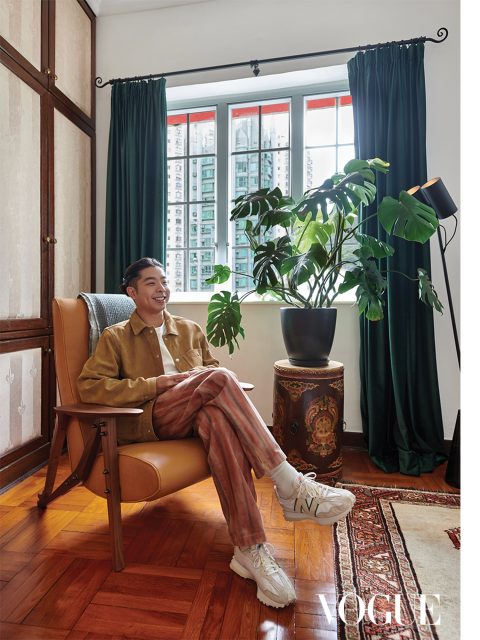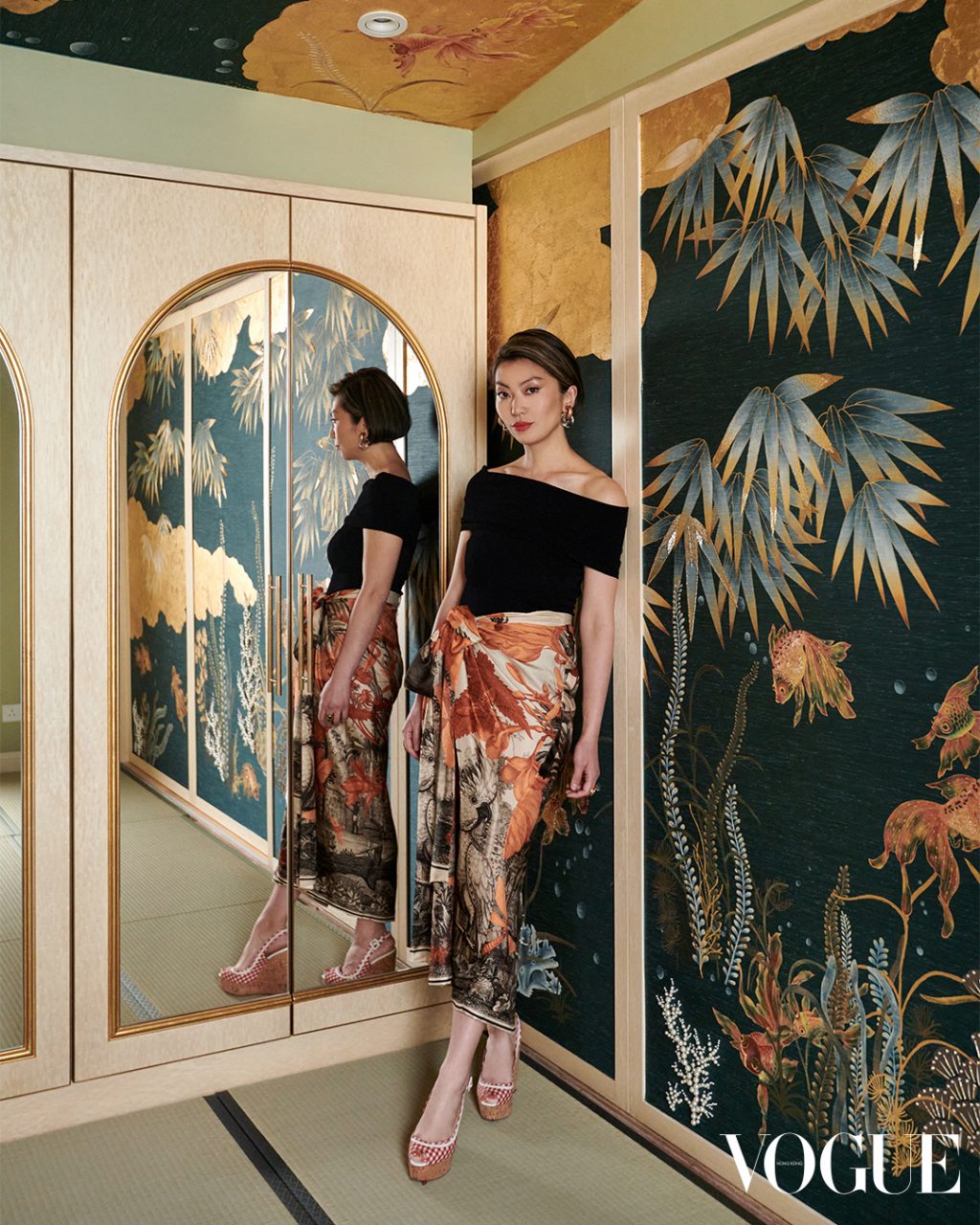He may be the new standard-bearer of pop stardom, but for Troye Sivan, the 25-year-old Aussie singer-songwriter and actor who rocketed to the top of global dance charts with self-penned intimacies sung over lush synth-soundscapes, the celebrity tropes are simply for smashing.
Starting with the hackneyed ‘star is born’ narrative that casts prodigious talent in underdog circumstance then plots for its lucky meet with a modern-day Svengali who dictates its loves, looks and living, Sivan has concertedly written his own script and regards fame without freedom as the seventh circle of hell; an abyss filled with hangers-on and overblown houses à la rapper 50 Cent, who famously bragged about 19 bedrooms, 25 bathrooms, a hot tub that fit 40, a nightclub and an indoor racquetball court before going bust.
“I think I’d be really sad if I woke up in a house by myself with 19 bedrooms,” says Sivan from the peachy bedroom peak of his new tri-level Melbourne home, a 19th-century hardball court set in a mews-style square reminiscent of residential London. “When I open all these windows up, and feel the texture of the carpet beneath my feet and the breeze over the top of the trees and watch people in the park enjoying what is truly the greatest city in the world, that makes me feel really, really happy.”
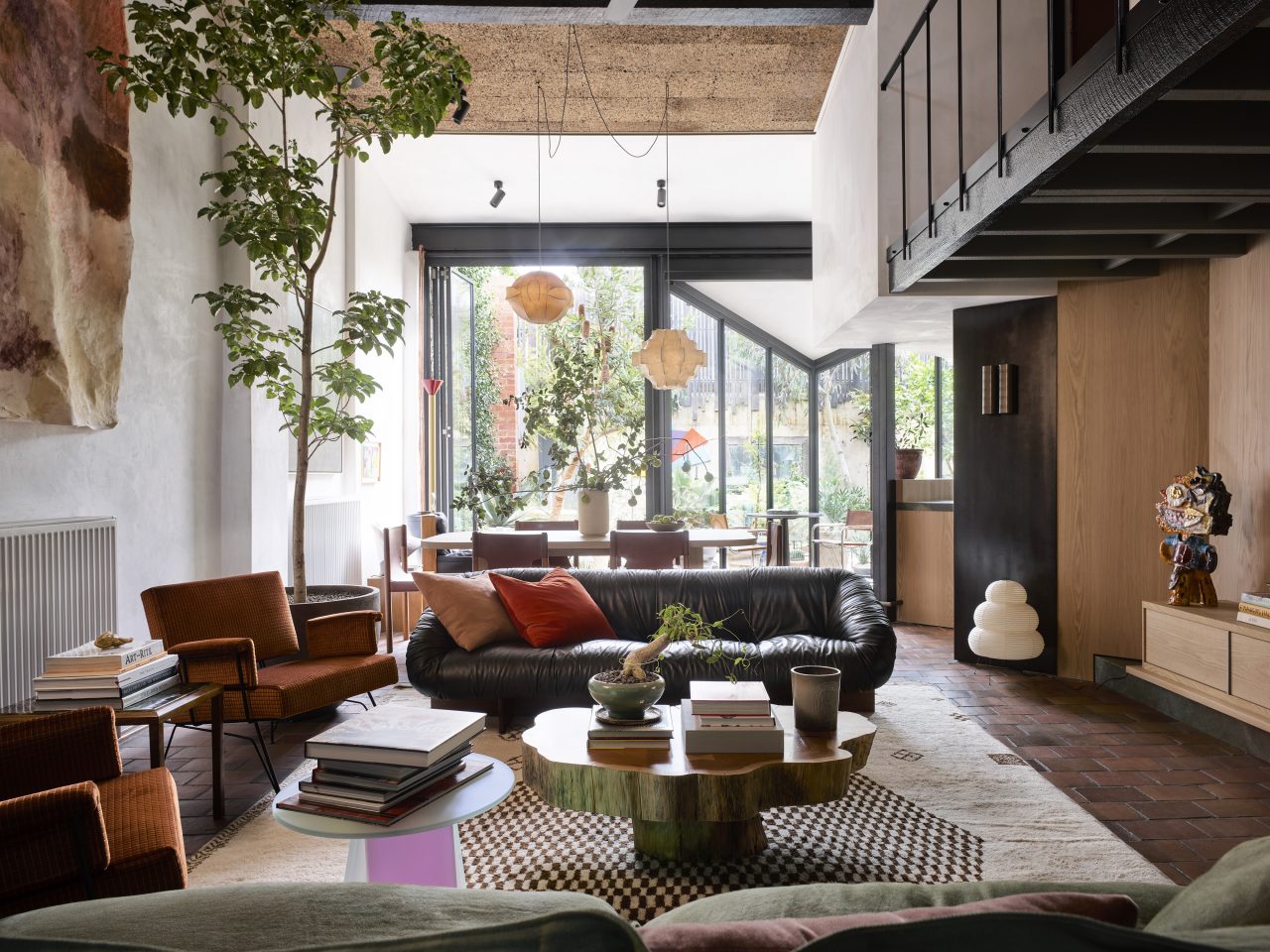
In the main living area of this Melbourne home, vintage Cerruti lounge chairs from Nicholas & Alistair; wall sconce designed by Flack Studio and produced by Alustain; Akari Light Sculpture 24N floor lamp by Isamu Noguchi for Vitra from Living Edge; render wall finish from Bishop Master Finishes; Becoming With 11 (2019) artwork (on left) by Jahnne Pasco-White from Station Gallery; Orange Figure with Big-Head (2020) sculpture by Ramesh Mario Nithiyendran from Sullivan+Strumpf.
Photo: Anson Smart
With a poise and personal insight beyond his spot-lit career and years, Sivan, who was born in South Africa and raised in Western Australia, communicates his idyll of home in terms of feelings rather than forms. He claims a design sensibility seeded in the peace and simplicity of Perth, the isolated city of endless sun, self-made millionaires and a can-do mindset that convinced a young Jewish teenager to out his talents and queerness on YouTube.
Sivan cut through the ether with a sensual emotionalism that now explains his love of Ilse Crawford’s design work. “She’s awesome,” he says, in recall of being smitten by Stockholm’s Ett Hem Hotel — the 12-room Arts and Crafts building that Crawford contrived into the lived-in home of an insinuated character. “Then I watched a documentary on her, talking about design and materiality and how it can change the way you experience life and it really hit home for me.”
Eschewing the type of arriviste high style that discourages jumping on the couch, Sivan adds that for him family is everything and always in his orbit, necessitating a serviceability of home for big dinners — “to celebrate Friday night Shabbat” — pet dogs and a projected future of little climbing feet. “Our life plan,” he says in reference to his three close siblings, who one by one moved to the Victorian capital with parents in pursuit, “is that one day we will all have our own families and raise them here [in Melbourne].”
It’s not the usual cynical speak of celebrity but a surprising expression of joy in the simple rhythms and dog-hair strewn realities of the everyday in a region that he believes has got it right. “You know the thing that I appreciate more than anything else when I’m here [in Australia] is the general approach to life — a grasp on what’s important and the prioritising of it: family, outdoor spaces, beers.”
He leans into the longing that has come from six years of living in Los Angeles where he regularly guests on late-night talk shows and casts in box-office movies, having garnered rave reviews for his role in the tale of teenage gay conversion Boy Erased and bagging a Golden Globe nomination for its soundtrack song ‘Revelation’. “That’s what I really miss when I’m overseas — everything seems to make sense here.”
But for all the espoused grounding of home, the point is made to Sivan that like ‘Fiddy’ he has succumbed to owning a racquetball court. Slippery slope? Sivan, a one-time Saint Laurent model and current Cartier ambassador, who now sports a ‘business at the front, party at the back’ mullet haircut just laughs and counts the modest three bedrooms and two bathrooms that cram into the space of his repurposed court, one dating back to the 1860s.
“The history of this site was just so exciting to me,” he says of the unexpected real estate purchase made during Melbourne’s Covid-19 lockdown. “The other day I calculated that the marks on the rear courtyard wall were likely made by hardballs 146 years ago. The fact that I’m 25 in this house that has such a layering of lives, it humbles me. There’s a real through line of love for the space, the architecture and the artistry of it.”
Though Sivan’s plans to buy into Melbourne were always a future proposition, he remembers March 12, 2020 as the day in Los Angeles “it felt like everything went to shit,” and March 13 as the day he was on a flight back to Australia. The move was presciently penned in the song, ‘Take Yourself Home’, a feature track on the melancholy EP In a Dream: “I’m tired of the city. Scream if you’re with me. If I’m gonna die, let’s die somewhere pretty.”
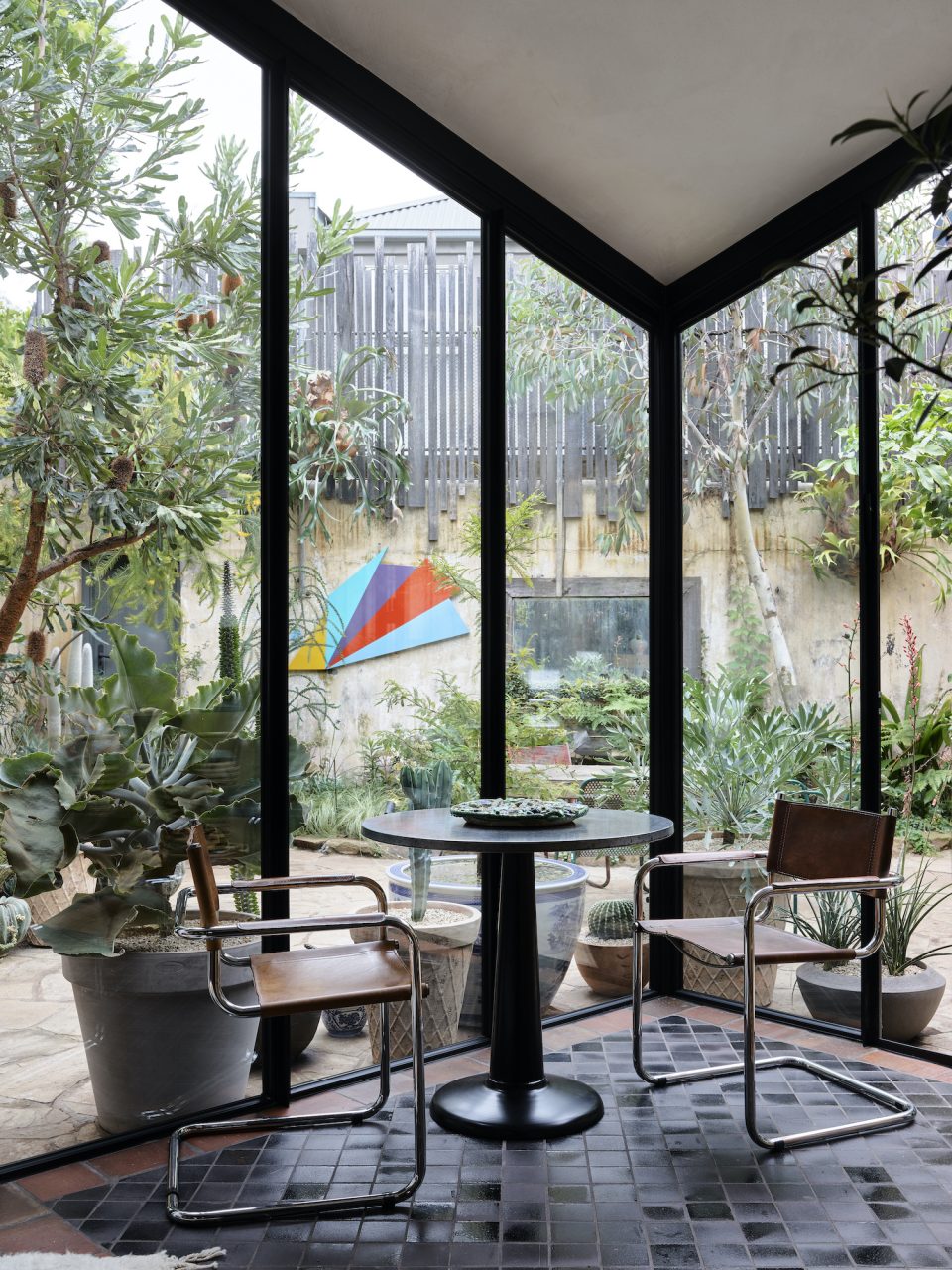
In the breakfast nook, vintage S33 chairs by Mart Stam for Thonet from Castorina & Co.; Tolix G table from Thonet; plate by Glenn Barkley from Sullivan+Strumpf; restored tiled floor; build by GRW Developments; landscape design by Florian Wild; Infinex 36 (2014) artwork by Sydney Ball from Sullivan+Strumpf.
Photo: Anson Smart
“It’s a song about waking up and wondering what am I actually doing here,” he says of LA. “Am I truly fulfilled and happy, which is not to say that I’m unhappy in America, but I don’t think I ever got the balance really right.”
The accompanying YouTube video — a bird’s eye flight over abandoned city — and the scroll-down of online comments tells his pining impacted with fans, one of whom questioned: “Does anyone feel like home is not the house they’re living in?” It’s such a fundamental ask of shelter, and the one that ultimately steered Sivan’s brief for the sensitive rejigging of his Melbourne dwelling, but the star confesses to lacking the confidence to call a designer.
“I started showing a friend some of my favourite houses around the world and they said you gotta work with Flack Studio,” he recalls. “The second I went on its Instagram, I think it was the Sandy Bay House in Tasmania [featured in the September/October 2019 issue of Vogue Living] — I was like, ‘OK, these guys get it.’”
David Flack, principal of said studio, later remembers the call coming through to the office mid-2020 and the following studio meet with a very “visceral” Sivan. “He knows how he wants to feel, and instantly struck me as an effortless, chilled and honest guy who would be lots of fun to work with,” he says. “Troye totally gets it.”
Again, with the ‘gets it’; that ephemeral something that Flack reckons to be the shared values elicited from endless conversations about everything from Wes Anderson movies to being queer to Black Lives Matter to the then “filthy orange man” in the White House.
David Flack, principal of said studio, later remembers the call coming through to the office mid-2020 and the following studio meet with a very “visceral” Sivan. “He knows how he wants to feel, and instantly struck me as an effortless, chilled and honest guy who would be lots of fun to work with,” he says. “Troye totally gets it.”
Again, with the ‘gets it’; that ephemeral something that Flack reckons to be the shared values elicited from endless conversations about everything from Wes Anderson movies to being queer to Black Lives Matter to the then “filthy orange man” in the White House.
Such suggestive thread-lines appealed to Sivan who “added to the site’s archaeology”, says Flack, with the purchase and placement of one of Ball’s hard-edged geometries on a courtyard wall still etched with markings. This injection of line and colour informed the landscaping hand of Rupert Bain, who was conceptually briefed to make it all appear as if “Grandma had collected these random plants and pots and didn’t know that she was great at gardening.”
“The house told us what to do,” says Flack, pointing to a glazed rear facade, now a pleating of fine black steelwork that dispensed with “the fizz and obstructive light flow” of old leadlights. He instated a new clarity of structure, continuing the line inside where an ill-sited bathroom was absorbed into a conservatory-style corner kitchen that reset with Le Corbusier-inflected oak cabinets, handmade tiles, a customised chopping-board bar — “the nightmare finesse of 360 fingers of oak” — and oxidised metals that would testify “to the passage of time and Troye”.
Such suggestive thread-lines appealed to Sivan who “added to the site’s archaeology”, says Flack, with the purchase and placement of one of Ball’s hard-edged geometries on a courtyard wall still etched with markings. This injection of line and colour informed the landscaping hand of Rupert Bain, who was conceptually briefed to make it all appear as if “Grandma had collected these random plants and pots and didn’t know that she was great at gardening.”
“The house told us what to do,” says Flack, pointing to a glazed rear facade, now a pleating of fine black steelwork that dispensed with “the fizz and obstructive light flow” of old leadlights. He instated a new clarity of structure, continuing the line inside where an ill-sited bathroom was absorbed into a conservatory-style corner kitchen that reset with Le Corbusier-inflected oak cabinets, handmade tiles, a customised chopping-board bar — “the nightmare finesse of 360 fingers of oak” — and oxidised metals that would testify “to the passage of time and Troye”.
Over the top of this subtle shift in materiality and making, realised by Flack’s A-team of art-end contractors, the designer began laying the aesthetic objectification of Sivan — a salon hang of contemporary Australian art and a careful select of furniture running the gamut from mid-century masters to modern crafters of comfort.
“This is by Maker & Son,” says Flack of a deep-set, down-filled sofa upholstered in a malachite linen, robust enough for Sivan’s specification of jumping. “Rather than shipping around the world, they set up satellites in countries and issue the templates for local making. It’s a bit of a ripper.”
The sofa’s comforting English bulk contra-posts the upright Italian posturing of vintage Cerruti velvet armchairs and the Brazilian entreaty to lie-back on a ’70s leather sofa by modernist Percival Lafer in a house-wide conversation between past and present lives.
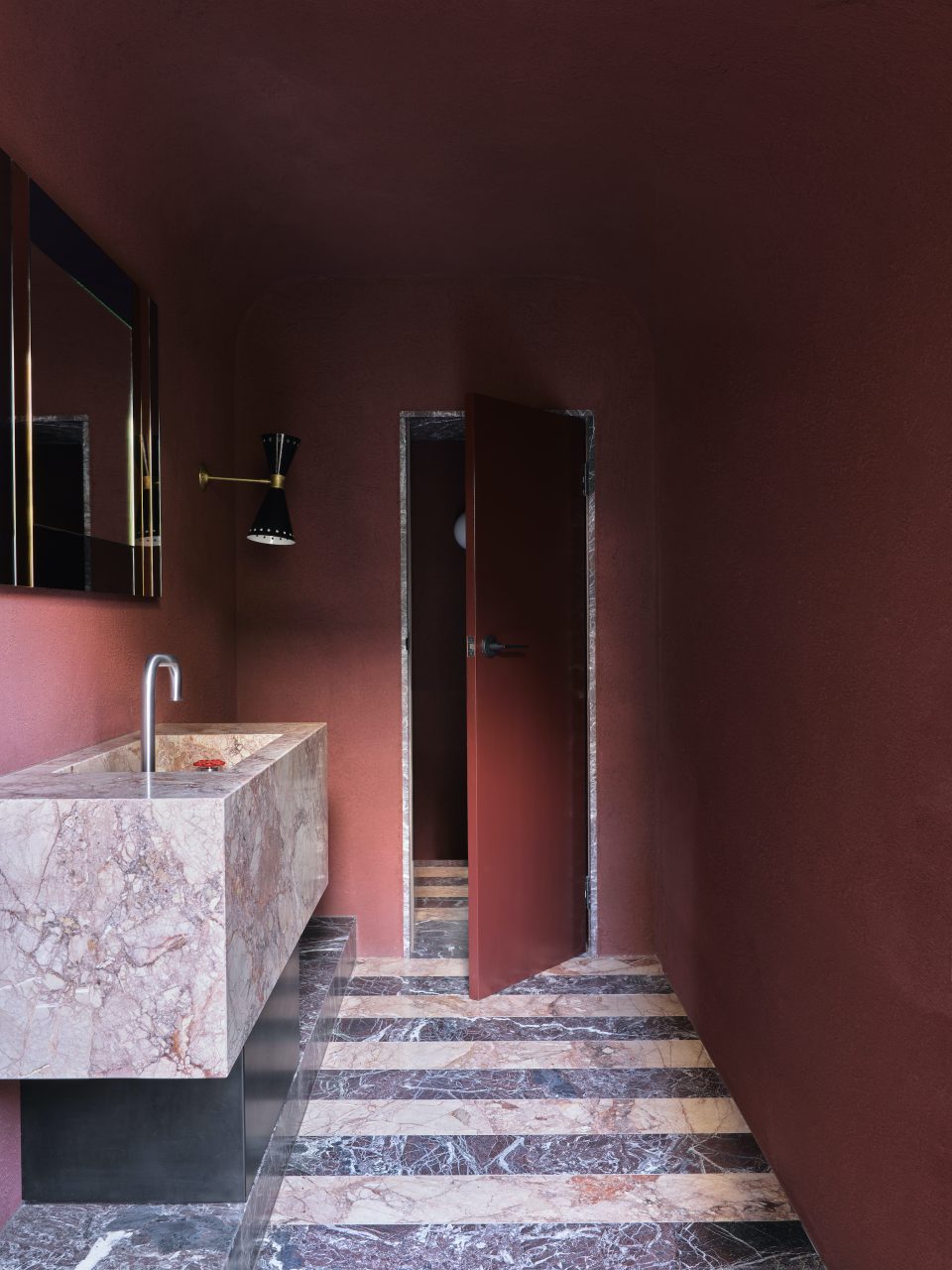
Bathed in oxblood paint, the powder room in the garden has a Flack Studio marble vanity with Boffi | De Padova fixtures.
Photo: Anson Smart
“It’s all underwritten by passion,” affirms Flack of the objects and occupants, then and now, that fed into the “heart and soul” effort of this project. That earnestness feeds back to Flack in the form of a lyric from one of Sivan’s hit-songs: “Cause passion is passion. You know it just as well as me.” The piss-take cracks a laugh from Flack, who joins in the follow-on chorus of client approval: “Oh my, my, my! Living for your every move…”
Photography: Anson Smart
Styling: Joseph Gardner
Editor
Annemarie Kiely








